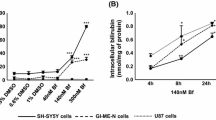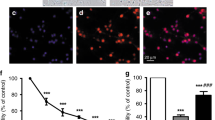Abstract
Severe hyperbilirubinemia leads to bilirubin encephalopathy in neonates, causing irreversible neurological sequelae. We investigated the nature of neuronal selective vulnerability to unconjugated bilirubin (UCB) toxicity. The maintenance of intracellular calcium homeostasis is crucial for neuron survival. Calcium release from endoplasmic reticulum (ER) during ER-stress can lead to apoptosis trough the activation of Caspase-12. By live calcium imaging we monitored the generation of calcium signals in dissociated hippocampal neurons and glial cells exposed to increasing UCB concentrations. We showed the ability of UCB to alter intracellular calcium homeostasis, inducing the appearance of repetitive intracellular calcium oscillations. The contribution of intracellular calcium stores and the induction and activation of proteins involved in the apoptotic calcium-dependent signaling were also assessed. Thapsigargin, a specific inhibitor of Sarco/endoplasmic reticulum ATPase (SERCA) pumps, significantly reduced the duration of Ca2+ oscillation associated with UCB exposure indicating that UCB strongly interfered with the reticulum calcium stores. On the contrary, in pure astrocyte cultures, spontaneous Ca2+ transient duration was not altered by UCB. The protein content of GRP78, AT6, CHOP, Calpain and Caspase-12 of neuronal cells treated with UCB for 24 h was at least twofold higher compared to controls. Calcium-dependent Calpain and Caspase-12 induction by UCB were significantly reduced by 50% and 98%, respectively when cells were pretreated with the ER-stress inhibitor 4-PBA. These results show the strong and direct interference of UCB with neuronal intracellular Ca2+ dynamics, suggesting ER Ca2+ stores as a primary target of UCB toxicity with the activation of the apoptotic ER-stress-dependent pathway.






Similar content being viewed by others

References
Ahlfors CE, Wennberg RP, Ostrow JD, Tiribelli C (2009) Unbound (free) bilirubin: improving the paradigm for evaluating neonatal jaundice. Clin Chem 55(7):1288–1299
Ahmad F, Das D, Kommaddi RP, Diwakar L, Gowaikar R, Rupanagudi KV et al (2018) Isoform-specific hyperactivation of calpain-2 occurs presymptomatically at the synapse in Alzheimer’s disease mice and correlates with memory deficits in human subjects. Sci Rep 8(1):13119
Antonenko YN, Rokitskaya TI, Cooper AJL, Krasnikov BF (2010) Minocycline chelates Ca2+, binds to membranes, and depolarizes mitochondria by formation of Ca2+-dependent ion channels. J Bioenerg Biomembr 42(2):151–163
Barateiro A, Vaz AR, Silva SL, Fernandes A, Brites D (2012) ER stress, mitochondrial dysfunction and calpain/JNK activation are involved in oligodendrocyte precursor cell death by unconjugated bilirubin. Neuromolecular Med 14(4):285–302
Bosi S, Rauti R, Laishram J, Turco A, Lonardoni D, Nieus T et al (2015) From 2D to 3D: novel nanostructured scaffolds to investigate signalling in reconstructed neuronal networks. Sci Rep 5:9562
Brito MA, Brites D, Butterfield DA (2004) A link between hyperbilirubinemia, oxidative stress and injury to neocortical synaptosomes. Brain Res 1026(1):33–43
Brito MA, Rosa AI, Falcão AS, Fernandes A, Silva RFM, Butterfield DA et al (2008) Unconjugated bilirubin differentially affects the redox status of neuronal and astroglial cells. Neurobiol Dis 29(1):30–40
Calegari F, Coco S, Taverna E, Bassetti M, Verderio C, Corradi N et al (1999) A regulated secretory pathway in cultured hippocampal astrocytes. J Biol Chem 274(32):22539–22547
Calligaris R, Bellarosa C, Foti R, Roncaglia P, Giraudi P, Krmac H et al (2009) A transcriptome analysis identifies molecular effectors of unconjugated bilirubin in human neuroblastoma SH-SY5Y cells. BMC Genomics 10:543
Daood MJ, Hoyson M, Watchko JF (2012) Lipid peroxidation is not the primary mechanism of bilirubin-induced neurologic dysfunction in jaundiced Gunn rat pups. Pediatr Res 72(5):455–459
Fabbro A, Pastore B, Nistri A, Ballerini L (2007) Activity-independent intracellular Ca2+ oscillations are spontaneously generated by ventral spinal neurons during development in vitro. Cell Calcium 41(4):317–329
Falcão AS, Fernandes A, Brito MA, Silva RFM, Brites D (2006) Bilirubin-induced immunostimulant effects and toxicity vary with neural cell type and maturation state. Acta Neuropathol 112(1):95–105
Gazzin S, Zelenka J, Zdrahalova L, Konickova R, Zabetta CC, Giraudi PJ et al (2012) Bilirubin accumulation and Cyp mRNA expression in selected brain regions of jaundiced Gunn rat pups. Pediatr Res 71(6):653–660
Geiger AS, Rice AC, Shapiro SM (2007) Minocycline blocks acute bilirubin-induced neurological dysfunction in jaundiced Gunn rats. Neonatology 92(4):219–226
Grienberger C, Konnerth A (2012) Imaging calcium in neurons. Neuron 73(5):862–885
Grojean S, Koziel V, Vert P, Daval JL (2000) Bilirubin induces apoptosis via activation of NMDA receptors in developing rat brain neurons. Exp Neurol 166(2):334–341
Kaufman RJ (1999) Stress signaling from the lumen of the endoplasmic reticulum: coordination of gene transcriptional and translational controls. Genes Dev 13(10):1211–1233
Lai E, Teodoro T, Volchuk A (2007) Endoplasmic reticulum stress: signaling the unfolded protein response. Physiology 22:193–201
Li G, Mongillo M, Chin K-T, Harding H, Ron D, Marks AR et al (2009) Role of ERO1-alpha-mediated stimulation of inositol 1,4,5-triphosphate receptor activity in endoplasmic reticulum stress-induced apoptosis. J Cell Biol 186(6):783–792
Liang M, Yin X-L, Shi H-B, Li C-Y, Li X-Y, Song N-Y, et al (2017) Bilirubin augments Ca2+ load of developing bushy neurons by targeting specific subtype of voltage-gated calcium channels. Sci Rep 7. https://www.ncbi.nlm.nih.gov/pmc/articles/PMC5427978/
Lin S, Wei X, Bales KR, Paul ABC, Ma Z, Yan G et al (2005) Minocycline blocks bilirubin neurotoxicity and prevents hyperbilirubinemia-induced cerebellar hypoplasia in the Gunn rat. Eur J Neurosci 22(1):21–27
Lovat V, Pantarotto D, Lagostena L, Cacciari B, Grandolfo M, Righi M et al (2005) Carbon nanotube substrates boost neuronal electrical signaling. Nano Lett 5(6):1107–1110
Manié SN, Lebeau J, Chevet E (2014) Cellular mechanisms of endoplasmic reticulum stress signaling in health and disease. 3. Orchestrating the unfolded protein response in oncogenesis: an update. Am J Physiol Cell Physiol 307(10):C901–907
McDonagh AF, Assisi F (1972) The ready isomerization of bilirubin IX-in aqueous solution. Biochem J 129(3):797–800
Mekahli D, Bultynck G, Parys JB, De Smedt H, Missiaen L (2011) Endoplasmic-reticulum calcium depletion and disease. Cold Spring Harb Perspect Biol 3(6):a004317
Nakagawa T, Yuan J (2000) Cross-talk between two cysteine protease families. Activation of caspase-12 by calpain in apoptosis. J Cell Biol 150(4):887–894
Nakagawa T, Zhu H, Morishima N, Li E, Xu J, Yankner BA et al (2000) Caspase-12 mediates endoplasmic-reticulum-specific apoptosis and cytotoxicity by amyloid-beta. Nature 403(6765):98–103
Oakes GH, Bend JR (2010) Global changes in gene regulation demonstrate that unconjugated bilirubin is able to upregulate and activate select components of the endoplasmic reticulum stress response pathway. J Biochem Mol Toxicol 24(2):73–88
Ostrow JD, Pascolo L, Tiribelli C (2003) Reassessment of the unbound concentrations of unconjugated bilirubin in relation to neurotoxicity in vitro. Pediatr Res 54(6):926
Ostrow JD, Pascolo L, Brites D, Tiribelli C (2004) Molecular basis of bilirubin-induced neurotoxicity. Trends Mol Med 10(2):65–70
Oyadomari S, Mori M (2004) Roles of CHOP/GADD153 in endoplasmic reticulum stress. Cell Death Differ 11(4):381–389
Pampaloni NP, Lottner M, Giugliano M, Matruglio A, D’Amico F, Prato M et al (2018) Single-layer graphene modulates neuronal communication and augments membrane ion currents. Nat Nanotechnol 13(8):755–764
Qaisiya M, Coda Zabetta CD, Bellarosa C, Tiribelli C (2014) Bilirubin mediated oxidative stress involves antioxidant response activation via Nrf2 pathway. Cell Signal 26(3):512–520
Qaisiya M, Brischetto C, Jašprová J, Vitek L, Tiribelli C, Bellarosa C (2017) Bilirubin-induced ER stress contributes to the inflammatory response and apoptosis in neuronal cells. Arch Toxicol 91(4):1847–1858
Rauti R, Medelin M, Newman L, Vranic S, Reina G, Bianco A et al (2019) Graphene oxide flakes tune excitatory neurotransmission in vivo by targeting hippocampal synapses. Nano Lett 19(5):2858–2870
Rauti R, Lozano N, León V, Scaini D, Musto M, Rago I et al (2016) Graphene oxide nanosheets reshape synaptic function in cultured brain networks. ACS Nano 10(4):4459–4471
Rice AC, Chiou VL, Zuckoff SB, Shapiro SM (2011) Profile of minocycline neuroprotection in bilirubin-induced auditory system dysfunction. Brain Res 1368:290–298
Roca L, Calligaris S, Wennberg RP, Ahlfors CE, Malik SG, Ostrow JD et al (2006) Factors affecting the binding of bilirubin to serum albumins: validation and application of the peroxidase method. Pediatr Res 60(6):724–728
Rodrigues CMP, Solá S, Brites D (2002) Bilirubin induces apoptosis via the mitochondrial pathway in developing rat brain neurons. Hepatology 35(5):1186–1195
Schiavon E, Smalley JL, Newton S, Greig NH, Forsythe ID (2018) Neuroinflammation and ER-stress are key mechanisms of acute bilirubin toxicity and hearing loss in a mouse model. PLoS ONE 13(8):e0201022
Seubert JM, Darmon AJ, El-Kadi AOS, D’Souza SJA, Bend JR (2002) Apoptosis in murine hepatoma hepa 1c1c7 wild-type, C12, and C4 cells mediated by bilirubin. Mol Pharmacol 62(2):257–264
Shah PT, Yoon KW, Xu XM, Broder LD (1997) Apoptosis mediates cell death following traumatic injury in rat hippocampal neurons. Neuroscience 79(4):999–1004
Silva RFM, Falcão AS, Fernandes A, Gordo AC, Brito MA, Brites D (2006) Dissociated primary nerve cell cultures as models for assessment of neurotoxicity. Toxicol Lett 163(1):1–9
Verkhratsky A (2005) Physiology and pathophysiology of the calcium store in the endoplasmic reticulum of neurons. Physiol Rev 85(1):201–279
Vodret S, Bortolussi G, Jašprová J, Vitek L, Muro AF (2017) Inflammatory signature of cerebellar neurodegeneration during neonatal hyperbilirubinemia in Ugt1 (−/−) mouse model. J Neuroinflamm 14(1):64
Vodret S, Bortolussi G, Iaconcig A, Martinelli E, Tiribelli C, Muro AF (2018) Attenuation of neuro-inflammation improves survival and neurodegeneration in a mouse model of severe neonatal hyperbilirubinemia. Brain Behav Immun 70:166–178
Watchko JF (2006) Kernicterus and the molecular mechanisms of bilirubin-induced CNS injury in newborns. Neuromolecular Med 8(4):513–529
Watchko JF, Tiribelli C (2013) Bilirubin-induced neurologic damage—mechanisms and management approaches. N Engl J Med 369(21):2021–2030
Zhang B, Yang X, Gao X (2010) Taurine protects against bilirubin-induced neurotoxicity in vitro. Brain Res 1320:159–167
Zucker SD, Goessling W, Hoppin AG (1999) Unconjugated bilirubin exhibits spontaneous diffusion through model lipid bilayers and native hepatocyte membranes. J Biol Chem 274(16):10852–10862
Acknowledgements
We thank FIF technician Sandra Leal for the purification of the amount of bilirubin needed to perform calcium imaging experiments. This work was supported in part by an intramural grant of Fondazione Italiana Fegato and by Taawon “Zamala Program” (Mohammed Qaisiya fellowship).
Author information
Authors and Affiliations
Corresponding authors
Ethics declarations
Conflict of interest
The authors report no conflicts of interest.
Additional information
Publisher's Note
Springer Nature remains neutral with regard to jurisdictional claims in published maps and institutional affiliations.
Electronic supplementary material
Below is the link to the electronic supplementary material.
Rights and permissions
About this article
Cite this article
Rauti, R., Qaisiya, M., Tiribelli, C. et al. Bilirubin disrupts calcium homeostasis in neonatal hippocampal neurons: a new pathway of neurotoxicity. Arch Toxicol 94, 845–855 (2020). https://doi.org/10.1007/s00204-020-02659-9
Received:
Accepted:
Published:
Issue Date:
DOI: https://doi.org/10.1007/s00204-020-02659-9



